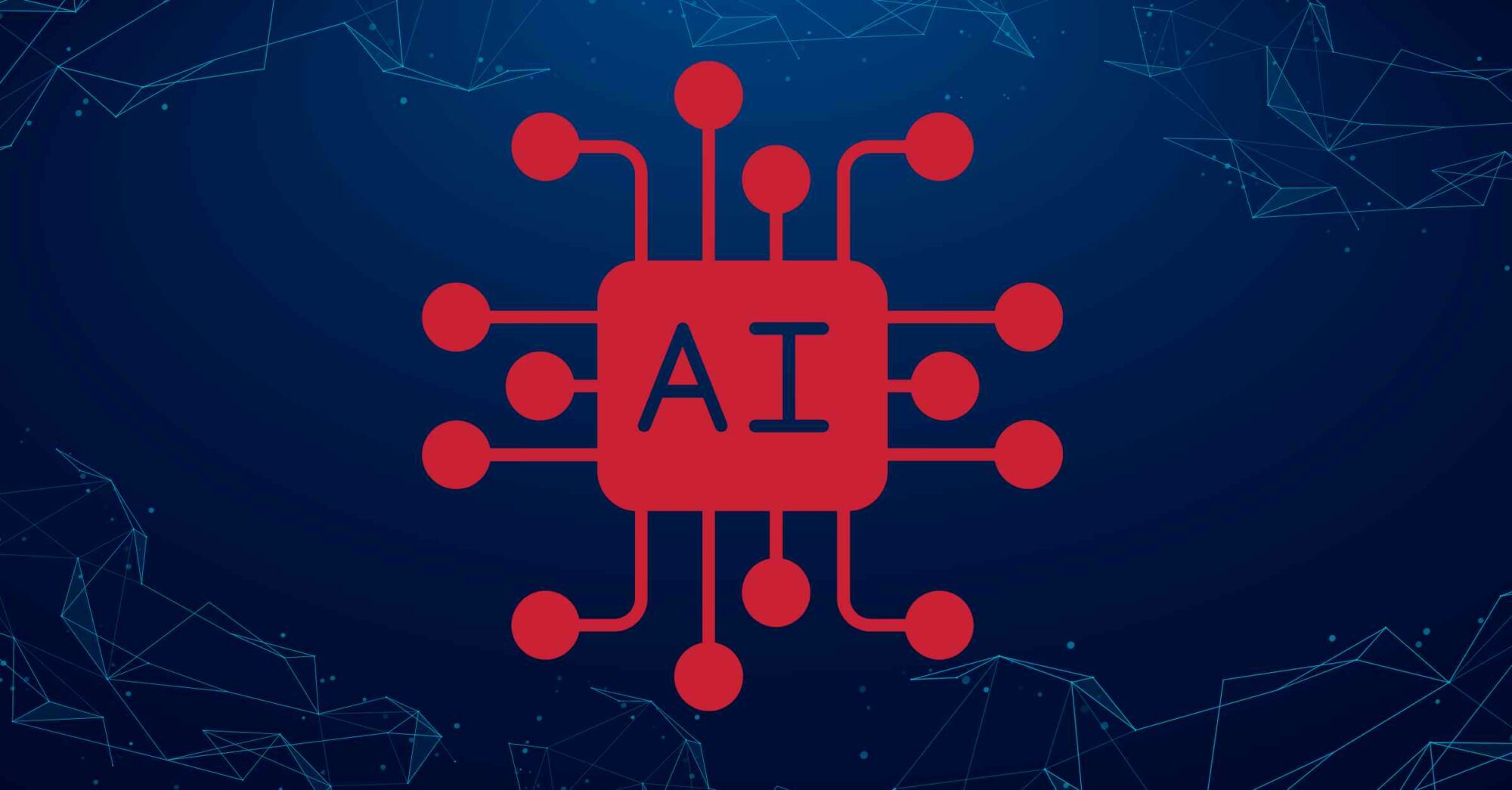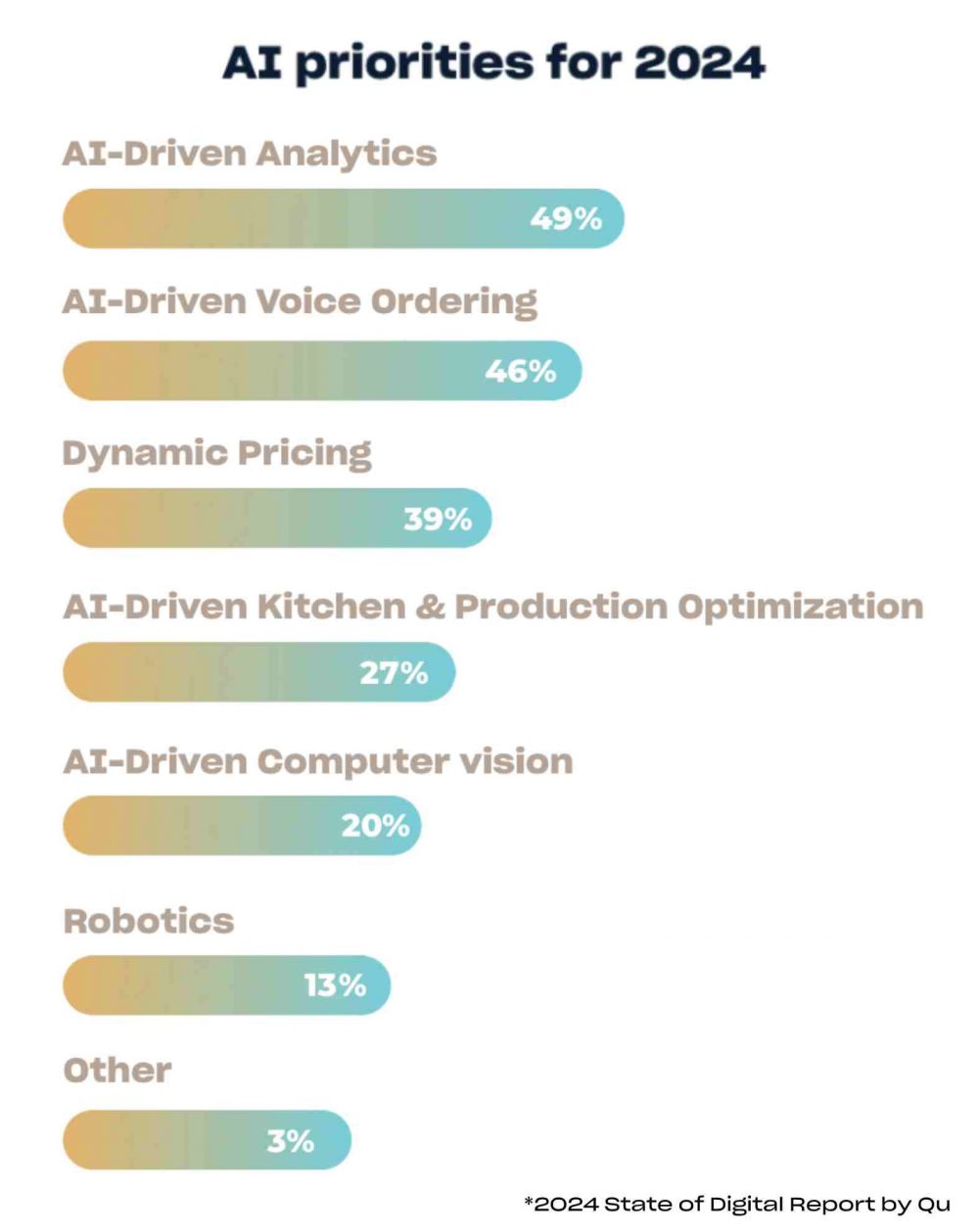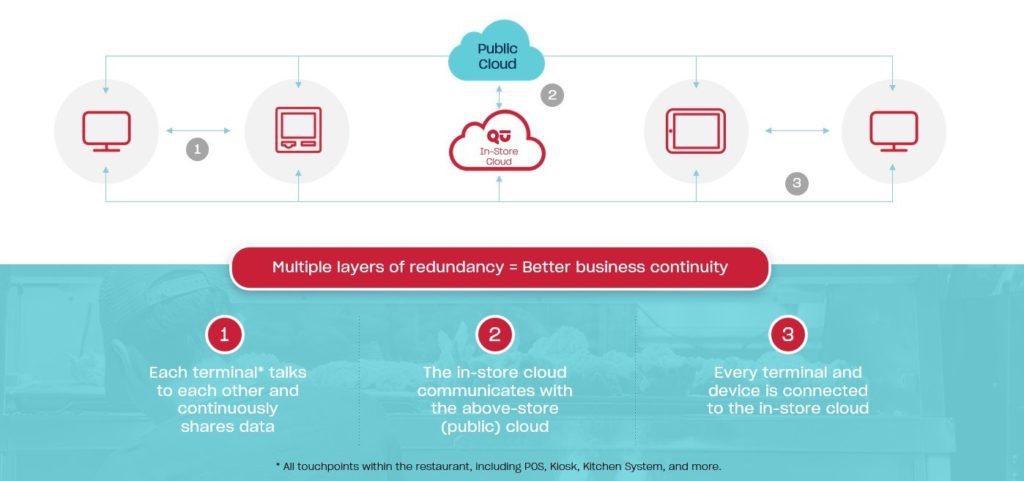It’s no surprise that Artificial Intelligence (AI) is top of mind for businesses globally. It has transitioned from being technical jargon to a staple in the boardroom and, consequently, management team discussions. While the restaurant industry has traditionally been slower to adopt new technology, AI stands out as a top priority for enterprise brands according to Qu’s 5th Annual State of Digital report.
Amidst the growing buzz, unlocking AI’s true potential remains challenging. While the promise of AI heralds greater convenience, consistency, and personalization, the journey toward realizing these benefits will take time for most restaurants.
At Qu, we believe there are 5 AI focus areas that restaurant leaders should consider adopting in 2024:
1. Conversational AI
2. AI-Enabled Alerting and Analytics
3. Optimized Food Production & Delivery
4. Dynamic Commerce
5. Robotic Automation & Computer Vision
Keep in mind that AI innovations shouldn’t be a “standalone solution” for your brand, but a value-added capability that’s integrated into your technology stack. Just looking at point solutions for AI to get a checkmark from your Board would be detrimental in the long run without ensuring that your current stack has the right foundation to build for the future.
We are in the very early stages of AI and the use cases will evolve within the restaurant ecosystem. One thing that won’t change is the need for a platform that is future-ready.
Leveraging and integrating AI solutions can have a huge impact on enterprise QSR and Fast Casual chains’ financial performance. Let’s explore how solutions from Qu and our Qu-Certified Partner Ecosystem can help drive the next phase of growth.
1. Improve Operations with Conversational AI
Voice-AI Ordering in the Drive-Through
A powerful use case that’s top of mind for chains is how Voice-AI ordering in the drive-through, and over the phone, can improve customer experience and help with labor efficiency.
Customers can personalize orders or seek assistance from Voice-AI ordering applications, which can seamlessly handle routine queries and effortlessly transition to human staff when complex requests arise. This ensures consistent and enjoyable interactions and gives you the flexibility to scale back on staff count, if needed, amidst rising labor costs.
It’s the right time to experiment with voice ordering while keeping in mind that the technology remains nascent. The good news is that there are several technology vendors offering solutions and investing millions of dollars to improve offerings. And more good news is that Qu is investing to certify integrations with leading providers of Voice AI services — so stay tuned for more here soon!
At Qu, we experimented with voice ordering solutions 3+ years ago. We concluded that the AI components of the technology — converting speech to text, translating that text into meaningful menu options, making sense of seemingly contradictory orders and/or changing orders — would evolve rapidly. No one in the industry predicted the rapid rise of advanced large language models and Generative AI technologies like ChatGPT. We felt that the real challenges of bringing AI into the store would be the speed, reliability, and connectivity of associated cloud technologies.
So, instead of solving the AI problems, we worked closely with Amazon to bring their AWS Cloud components into the store through our In-Store Cloud. It turned out that what we predicted as challenges were exactly the problems that would vex many Voice-AI ordering technologies. We’re now working closely with many of the leading providers of Voice AI services to leverage our In-Store Cloud to address the latency and speed issues related to voice ordering.
Qu’s In-Store Cloud enables restaurants to run all ordering and commerce transactions faster and more reliably, whether it’s in the store or on digital channels:
Real-time insights
Another use case for conversational AI is around real-time insights. Picture having an assistant capable of analyzing sales data and delivering real-time insights with a simple voice command in seconds. Or comparing that data to previous days, weeks, or even years. The power of actionable insights goes beyond sales data to include any data that’s relevant to your store performance.
With Notify, an Apple iOS and Android application from Qu, conversational chats facilitate real-time access to critical information. Just ask about this week’s revenue, which menu items are hot right now, or how your labor costs are trending versus sales, and Notify serves up the answers you need in seconds.
2. Harness the Power of Data with AI-Enabled Alerting and Analytics
Proactive AI promises a future where AI not only understands our language and can react to questions, but also anticipates our needs before you even ask. Why not let your technology constantly analyze your real-time data and alert you when something needs to be looked into?
Qu’s Notify app provides advanced analytics and reporting — powered by AI and Machine Learning (ML) — that empowers brands with more data-driven insights to activate immediately, driving better business results. Receive proactive alerts in real-time as issues occur, ensuring timely response without delay. Gain critical insights before the need to inquire, surpassing mere human anticipation.
Notify was built with AI from the start, not just bolted on when AI started trending. The app lets you define topics and parameters you care about so it can alert you when results don’t match your projections.
Features like anomaly detection highlight unusual sales trends, while predictive analytics aid in making informed decisions in real-time. With Notify, brands gain:
- Real-time access to data, reporting, and predictive analytics
- Comprehensive sales performance insights across all stores
- Timely notifications on critical business changes
3. Optimizing Food Production and Delivery
For QSR operators, solving for food cost efficiency versus speed of service has been the holy grail of challenges. You can keep the drive-thru moving efficiently if you have more than what you might need prepared just in time. But that leads to higher waste, or worse yet, serving food that might be past its prime usage period. If you prioritize waste reduction, it may end up hurting speed of service. The missing piece in all of this is better managing the variability in digital orders and more accurately providing promised delivery times.
As digital orders have exploded, broken promises of delivery times have become the leading cause of guest dissatisfaction. These two problems present a perfect use case for advanced ML and AI algorithms.
Qu Production Optimization Board leverages vast data streams—such as real-time omnichannel ordering trends, promised order ready times relative to delivery actuals, and historical and seasonal trends—to deliver dynamic production recommendations. Our Production Optimization Board learns from historical demand signals, real-time trends, and other external signals to dynamically suggest the right amount of food to produce in advance of expected demand — so you can improve the speed of service and minimize waste.

4. Strategically Stimulating Demand with Dynamic Commerce
When applied to the right datasets, advanced machine learning (ML) can optimize:
- Pricing
- Discounts
- Upsells
- Labor scheduling
- Inventory management
- And more…
ML-model outputs, or inferences, dynamically optimize Unified Commerce Platforms from both the applications and services that Qu provides and the bi-directional integrations from Qu-Certified Partner offerings.
Dynamic pricing has been a hot topic as of late and can be an excellent way to boost sales during off-peak hours. While there has been significant consumer backlash to dynamic pricing in the restaurant industry, the issue also suffers from potentially poor messaging — the same concept, presented as ‘dynamic promotions’ would get a very different response. The technology required to do either is the same, and available today.
When rolling out dynamic pricing, it’s about positioning and leading with the true value proposition customers care about — discounts, promotions, and premium offerings vs. the dreaded “increased pricing.”
Qu’s collaborations with industry leaders like Juicer enable AI-powered dynamic pricing, personalized promotions, and menu optimization to help brands strategically stimulate demand.
5. Unlock the Power of Robotic Automation and Computer Vision
Automation of repetitive back-of-house tasks can enhance operational efficiency, reduce costs, and improve productivity. From automated order preparation to streamlined kitchen processes, Qu integrates cutting-edge robotics and process automation technologies to help your teams get more done, faster. A well-known example of Robotic automation is ‘Flippy’, the robotic device from Miso Robotics that fries items from french fries to chicken nuggets. While still in prototype and early testing, it’s an example of exciting things to come.
Similarly, sensor fusion and computer vision technologies are top of mind for many, with 20% of brands prioritizing AI-driven computer vision investments this year. Several use cases are being tested, including camera-based drive-throughs to automate ‘knowing the guest’ and food preparation and packaging quality monitoring. These offerings provide real-time insights and support data-driven decision-making.
Qu’s Integrations with partners like DTiQ and Solink empower brands to optimize operations, mitigate risks, and uphold food safety standards.
The Future of AI in Restaurants
As we navigate the AI landscape, two guiding principles remain at the forefront:
- Always prioritize customer-centric innovations
- Support staff in delivering exceptional service
Technological advancements will continue to shape dining experiences. Qu remains committed to developing intelligent solutions that streamline operations and elevate customer experiences.
AI is not new to Qu. We’ve been baking AI solutions into our foundational platform for over five years. We’re eager to see the transformational impact it has on our industry. Stay tuned here as Qu continues to illuminate how AI transforms the restaurant industry, and check out our recent webinar with Soundhound AI where we discuss the future of restaurant technology and how it’s empowering restaurants to adapt and thrive amidst evolving customer preferences.





